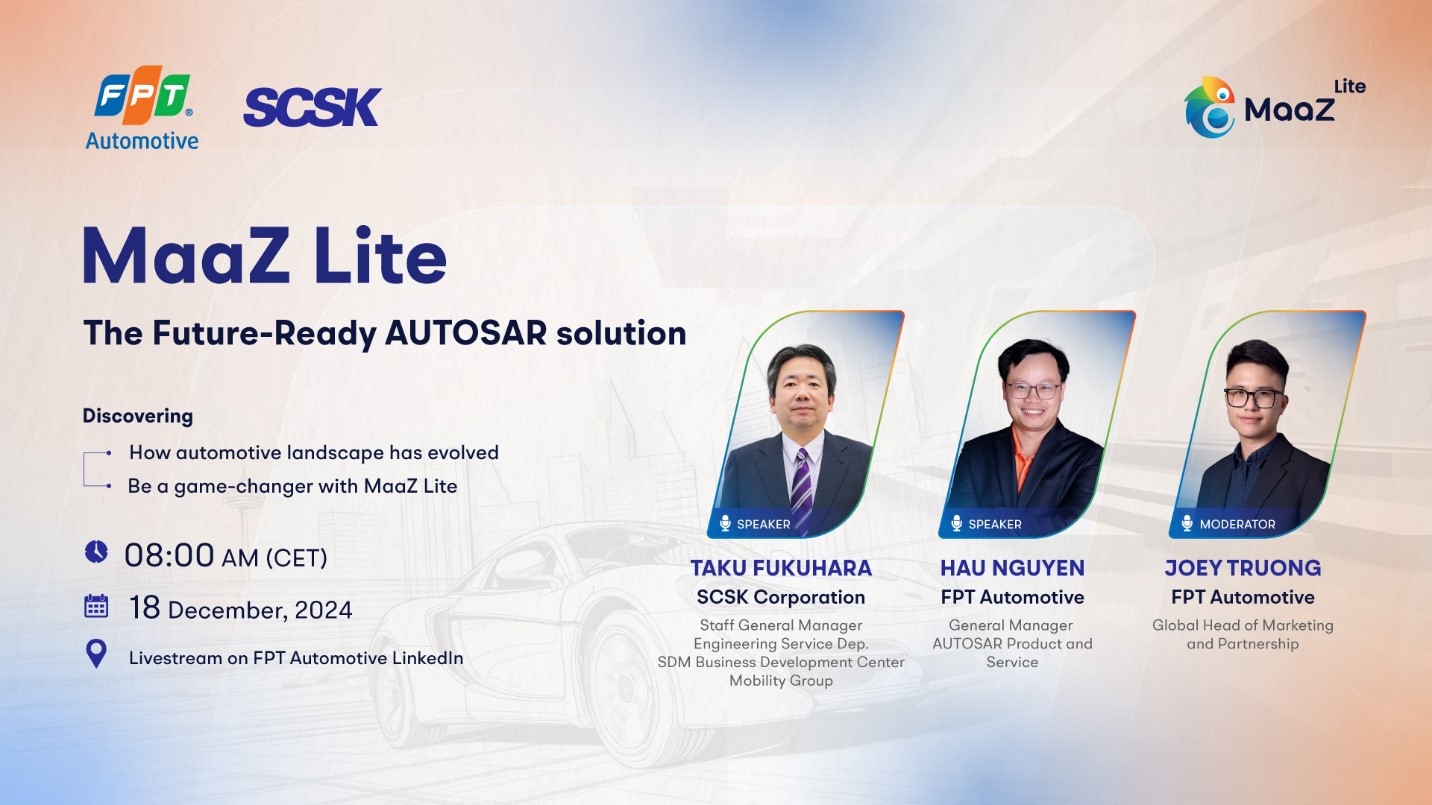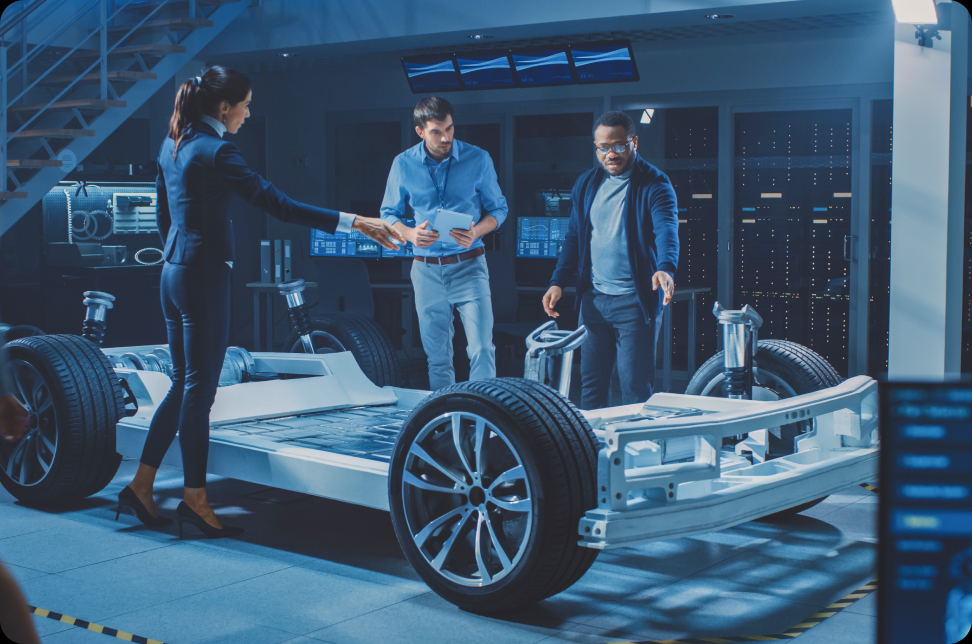

Capturing Potential Values of Generative AI in Automotive
07-08-2024

<p><font color="#ffffff"><span style="font-family: "Segoe UI";"></span><em style="margin: 0px; padding: 0px; border: 0px; outline: 0px; font-family: Inter; vertical-align: baseline; line-height: 28px; max-width: 100%; height: auto; letter-spacing: 0.16px;"><span style="font-family: "Segoe UI";">Amidst recent advancements and moving forward, AI has transformed itself from a concept to practical applications across industries, from finance, marketing, to automotive. Generative AI, in particular, is revolutionizing automotive practices by embedding advanced intelligence into various processes, such as generating automotive designs and creating personalized driving experiences. Its impact is undeniable, with </span><a href="https://www2.deloitte.com/content/dam/Deloitte/us/Documents/consulting/us-state-of-gen-ai-report.pdf" target="_blank" style="text-decoration-line: underline; margin: 0px; padding: 0px; border: 0px; outline: 0px; font-style: inherit; vertical-align: baseline; line-height: 28px; max-width: 100%; height: auto; cursor: pointer; letter-spacing: 0.01em;"><span style="font-family: "Segoe UI";">79% of industry leaders </span></a><span style="font-family: "Segoe UI";">anticipating generative AI to drive substantial transformations within their organizations and sectors in the coming three years.</span></em></font></p><p><em style="margin: 0px; padding: 0px; border: 0px; outline: 0px; font-family: Inter; vertical-align: baseline; line-height: 28px; max-width: 100%; height: auto; letter-spacing: 0.16px;"><span style="font-family: "Segoe UI";"><font color="#ffffff"><br></font></span></em></p><h2 style="margin: 10px 0px; font-family: Inter; line-height: 28px; color: rgb(33, 37, 41); font-size: 16px; padding: 0px; border: 0px; outline: 0px; vertical-align: baseline; max-width: 100%; height: auto; letter-spacing: 0.16px;"><span id="section1" data-id="scrollspy" style="font-weight: 600; margin: 0px; padding: 0px; border: 0px; outline: 0px; font-style: inherit; font-size: 18px; vertical-align: baseline; line-height: 28px; max-width: 100%; height: auto; letter-spacing: 0px; scroll-margin-top: 96px; display: block; font-family: "Segoe UI";"><font color="#ffffff">Preventing vehicular security breaches</font></span></h2><p style="margin: 20px 0px; padding: 0px; border: 0px; outline: 0px; font-family: Inter; vertical-align: baseline; line-height: 28px; max-width: 100%; height: auto; letter-spacing: 0.16px; text-align: justify;"><font color="#ffffff"><span style="font-family: "Segoe UI";">Cybersecurity attacks are one of the critical challenges for any industry, and the automotive sector is no exception. In March 2022, a German subsidiary of a prominent car manufacturer faced a cyberattack orchestrated by the Pandora ransomware group. The attackers extracted </span><a href="https://www.kelacyber.com/wp-content/uploads/2022/08/KELA-RESEARCH_Germany-Automotive-Sector-Cybercrime-Threat-Landscape.pdf" target="_blank" style="text-decoration-line: underline; margin: 0px; padding: 0px; border: 0px; outline: 0px; font-style: inherit; vertical-align: baseline; line-height: 28px; max-width: 100%; height: auto; cursor: pointer; letter-spacing: 0.01em; text-align: left;"><span style="font-family: "Segoe UI";">a substantial 1.4 TB of data</span></a><span style="font-family: "Segoe UI";"> from the company's systems, with screenshots of confidential purchase orders, detailed automotive technical diagrams, and internal emails on their public platform. Such incidents are a wake-up call for robust cybersecurity measures within the automotive sector, and genAI can be the solution. </span></font></p><p style="margin: 20px 0px; padding: 0px; border: 0px; outline: 0px; font-family: Inter; vertical-align: baseline; line-height: 28px; max-width: 100%; height: auto; letter-spacing: 0.16px; text-align: justify;"><span style="font-family: "Segoe UI";"><font color="#ffffff"><br></font></span></p><p><img src="https://imagemaaz2023.blob.core.windows.net/images/capturing-the-potential-01.webp" style="width: 1170px; display: block; margin-right: auto; margin-left: auto;"><em style="margin: 0px; padding: 0px; border: 0px; outline: 0px; font-family: Inter; vertical-align: baseline; line-height: 28px; max-width: 100%; height: auto; letter-spacing: 0.16px;"><font color="#ffffff"><br></font></em></p><p><em style="margin: 0px; padding: 0px; border: 0px; outline: 0px; font-family: Inter; vertical-align: baseline; line-height: 28px; max-width: 100%; height: auto; letter-spacing: 0.16px;"><font color="#ffffff"><span style="font-style: normal; letter-spacing: 0.16px; text-align: justify; font-family: "Segoe UI";">Generative AI can analyze vast amounts of data to identify unusual patterns and behaviors indicative of potential cyber threats. By learning from historical attack data and evolving threat landscapes, AI systems can improve their ability to detect attacks in real-time. Once a threat is detected, generative AI can automate responses to mitigate the impact by isolating affected systems or blocking malicious IP addresses. For this reason, </span><a href="https://www.blackberry.com/us/en/company/newsroom/press-releases/2023/chatgpt-may-already-be-used-in-nation-state-cyberattacks-say-it-decision-makers-in-blackberry-global-research?ref=cybersixgill-news" target="_blank" style="text-decoration-line: underline; margin: 0px; padding: 0px; border: 0px; outline: 0px; font-style: normal; vertical-align: baseline; line-height: 28px; max-width: 100%; height: auto; cursor: pointer; letter-spacing: 0.16px;"><span style="font-family: "Segoe UI";">82% of IT decision-makers</span></a><span style="font-style: normal; letter-spacing: 0.16px; text-align: justify; font-family: "Segoe UI";"> intend to invest in AI-driven cybersecurity within the next two years.</span></font></em></p><p><em style="margin: 0px; padding: 0px; border: 0px; outline: 0px; font-family: Inter; vertical-align: baseline; line-height: 28px; max-width: 100%; height: auto; letter-spacing: 0.16px;"><span style="font-style: normal; letter-spacing: 0.16px; text-align: justify; font-family: "Segoe UI";"><font color="#ffffff"><br></font></span></em></p><p><em style="margin: 0px; padding: 0px; border: 0px; outline: 0px; font-family: Inter; vertical-align: baseline; line-height: 28px; max-width: 100%; height: auto; letter-spacing: 0.16px;"><font color="#ffffff"><span style="font-style: normal; letter-spacing: 0.16px; text-align: justify; font-family: "Segoe UI";">Generative AI can be used to simulate and predict potential attack scenarios based on existing vulnerabilities and threat intelligence. This approach helps organizations prepare for and defend against emerging threats before they occur. For example, a leading automotive manufacturer has significantly improved the security of its Vehicle-to-Everything (V2X) communication systems with generative AI. The company utilized generative models to simulate various network attack scenarios, allowing the defensive mechanisms of the network to be trained and tested against imminent breaches. Thus, they could effectively mimic different types of threats by employing Variational Autoencoders (VAEs) and Generative Adversarial Networks (GANs) to create synthetic attack data. As a result, the manufacturer noted a substantial decrease in breaches, with the network detecting and responding to </span><a href="https://arxiv.org/html/2407.11020v1" target="_blank" style="text-decoration-line: underline; margin: 0px; padding: 0px; border: 0px; outline: 0px; font-style: normal; vertical-align: baseline; line-height: 28px; max-width: 100%; height: auto; cursor: pointer; letter-spacing: 0.16px;"><span style="font-family: "Segoe UI";">90% of simulated attacks </span></a><span style="font-style: normal; letter-spacing: 0.16px; text-align: justify; font-family: "Segoe UI";">during the testing phases. </span><span style="font-style: normal; letter-spacing: 0.16px; text-align: justify; font-family: "Segoe UI";"><br></span></font></em></p><h2 id="section2" data-id="scrollspy" style="margin: 10px 0px; font-family: Inter; font-weight: 600; line-height: 28px; color: rgb(33, 37, 41); font-size: 18px; letter-spacing: 0px; padding: 0px; border: 0px; outline: 0px; vertical-align: baseline; max-width: 100%; height: auto; scroll-margin-top: 96px;"><span style="font-family: "Segoe UI";"><font color="#ffffff"><br></font></span></h2><h2 id="section2" data-id="scrollspy" style="margin: 10px 0px; font-family: Inter; font-weight: 600; line-height: 28px; color: rgb(33, 37, 41); font-size: 18px; letter-spacing: 0px; padding: 0px; border: 0px; outline: 0px; vertical-align: baseline; max-width: 100%; height: auto; scroll-margin-top: 96px;"><span style="font-family: "Segoe UI";"><font color="#ffffff">Generating and refining automotive designs </font></span></h2><p><font color="#ffffff"><em style="margin: 0px; padding: 0px; border: 0px; outline: 0px; font-family: Inter; vertical-align: baseline; line-height: 28px; max-width: 100%; height: auto; letter-spacing: 0.16px;"><span style="font-style: normal; letter-spacing: 0.16px; text-align: justify; font-family: "Segoe UI";">Generative AI is transforming automotive design by creating innovative vehicle designs. Utilizing generative design, genAI can automatically generate multiple design options to help manufacturers find the most effective solutions. Generative designs can significantly accelerate the design process and refine automotive components. According to Precedence Research, integrating generative AI in the automotive parts sector can </span><a href="https://www.precedenceresearch.com/generative-ai-in-automotive-market" target="_blank" style="text-decoration-line: underline; margin: 0px; padding: 0px; border: 0px; outline: 0px; font-style: normal; vertical-align: baseline; line-height: 28px; max-width: 100%; height: auto; cursor: pointer; letter-spacing: 0.16px;"><span style="font-family: "Segoe UI";">decrease development costs and time up to 20%</span></a><span style="font-style: normal; letter-spacing: 0.16px; text-align: justify; font-family: "Segoe UI";">, enabling manufacturers to lower production expenses and expedite time-to-market.</span><br></em><br></font></p><p><img src="https://imagemaaz2023.blob.core.windows.net/images/capturing-the-potential-02.webp" style="width: 626px; display: block; margin-right: auto; margin-left: auto;"><span style="font-family: Inter; letter-spacing: 0.16px; text-align: justify;"><font color="#ffffff"><br></font></span></p><p><span style="font-family: "Segoe UI"; letter-spacing: 0.16px; text-align: justify;"><font color="#ffffff">Toyota Research Institute (TRI) has integrated a generative AI tool that enables designers to generate design sketches based on text descriptions, specifying stylistic attributes such as "sleek," "SUV-like," and "modern." Traditionally, Toyota’s diverse team of designers and engineers encountered challenges where designs often fell short of meeting engineering requirements, which required prolonged collaboration and iterative adjustments. The new AI tool tackles this issue by integrating multiple data inputs, including engineering constraints, to propose designs that satisfy aesthetic preferences and technical specifications. This integration helps the designers focus on refining stylistic elements while meeting critical engineering criteria.</font></span></p><p><span style="font-family: "Segoe UI"; letter-spacing: 0.16px; text-align: justify;"><font color="#ffffff"><br></font></span></p><h2 id="section3" data-id="scrollspy" style="margin: 10px 0px; font-family: Inter; font-weight: 600; line-height: 28px; color: rgb(33, 37, 41); font-size: 18px; letter-spacing: 0px; padding: 0px; border: 0px; outline: 0px; vertical-align: baseline; max-width: 100%; height: auto; scroll-margin-top: 96px;"><span style="font-family: "Segoe UI";"><font color="#ffffff">Towards a more connected and personalized driver experience</font></span></h2><p><font color="#ffffff"><span style="font-family: "Segoe UI"; letter-spacing: 0.16px; text-align: justify;">As cars are becoming more connected and advanced, delivering an exceptional driver experience has become crucial for manufacturers. However, many original equipment manufacturers (OEMs) are struggling to leverage AI effectively to enhance the customer experience. For example, a recent Boston Consulting Group (BCG) study revealed that, while the quality of the car-buying experience is the most important decision factor for many customers, </span><a href="https://www.bcg.com/x/the-multiplier/gen-ai-revolutionizing-automotive-customer-experience" target="_blank" style="text-decoration-line: underline; margin: 0px; padding: 0px; border: 0px; outline: 0px; font-family: Inter; vertical-align: baseline; line-height: 28px; max-width: 100%; height: auto; cursor: pointer; letter-spacing: 0.16px;"><span style="font-family: "Segoe UI";">only 52% of customers </span></a><span style="font-family: "Segoe UI"; letter-spacing: 0.16px; text-align: justify;">say they are completely satisfied with their most recent car-buying experience.</span></font></p><p style="margin: 20px 0px; padding: 0px; border: 0px; outline: 0px; font-family: Inter; vertical-align: baseline; line-height: 28px; max-width: 100%; height: auto; letter-spacing: 0.16px; text-align: justify;"><span style="font-family: "Segoe UI";"><font color="#ffffff">By harnessing the power of generative AI, OEMs can elevate the customer experience and surpass their competitors in a fast-evolving market. Unlike traditional voice command systems which rely on pre-programmed responses, this advanced technology can be integrated into vehicles to enhance control over various systems, such as car functions and infotainment, through voice activation. Thus, drivers can engage in a meaningful conversation with their in-car voice assistant to discuss the latest news, explore nearby points of interest, or check the weather - all in a natural, conversational manner. </font></span></p><p style="margin: 20px 0px; padding: 0px; border: 0px; outline: 0px; font-family: Inter; vertical-align: baseline; line-height: 28px; max-width: 100%; height: auto; letter-spacing: 0.16px; text-align: justify;"><span style="font-family: "Segoe UI";"><font color="#ffffff"><br></font></span></p><p><img src="https://imagemaaz2023.blob.core.windows.net/images/capturing-the-potential-03.webp" style="width: 1500px; display: block; margin-right: auto; margin-left: auto;"><span style="font-family: "Segoe UI"; letter-spacing: 0.16px; text-align: justify;"><font color="#ffffff"><br></font></span></p><p><font color="#ffffff"><span style="font-family: "Segoe UI"; letter-spacing: 0.16px; text-align: justify;">Notably, Volkswagen - a German automobile manufacturer - introduced the first vehicle in which the artificial intelligence-based chatbot ChatGPT was integrated into its IDA voice assistant. Starting in the second quarter of 2024, many Volkswagen models will include ChatGPT as a standard feature, making Volkswagen the first automotive manufacturer to offer this capability. The IDA voice assistant, now enhanced with ChatGPT, will manage various functions (infotainment, navigation, and air conditioning), and answer general knowledge questions. For instance, instead of reading the news while on the road, drivers can have researched content read to them, which can prevent accidents and enhance safety.</span><span style="font-family: "Segoe UI"; letter-spacing: 0.16px; text-align: justify;"><br></span></font></p><p><span style="font-family: "Segoe UI"; letter-spacing: 0.16px; text-align: justify;"><font color="#ffffff"><br></font></span></p><h2 id="section4" data-id="scrollspy" style="margin: 10px 0px; font-family: Inter; font-weight: 600; line-height: 28px; color: rgb(33, 37, 41); font-size: 18px; letter-spacing: 0px; padding: 0px; border: 0px; outline: 0px; vertical-align: baseline; max-width: 100%; height: auto; scroll-margin-top: 96px;"><span style="font-family: "Segoe UI";"><font color="#ffffff">Harmonizing humans and genAI innovations</font></span></h2><p><span style="font-family: "Segoe UI"; letter-spacing: 0.16px; text-align: justify;"><font color="#ffffff">Despite the latest applications of genAI, human involvement remains crucial in harnessing generative AI to drive safety and ethical development. While generative AI can enhance design processes, human creativity still prevails with more visionary ideas that truly resonate with customers. Additionally, the adoption of AI introduces risks such as cybersecurity vulnerabilities. By adopting responsible AI practices and enforcing stringent guidelines to protect sensitive data, automotive manufacturers can harness its potential while maintaining safety, privacy, and public trust in AI-powered vehicles.</font></span></p>





